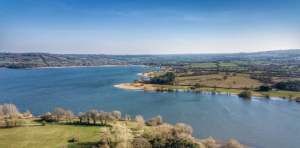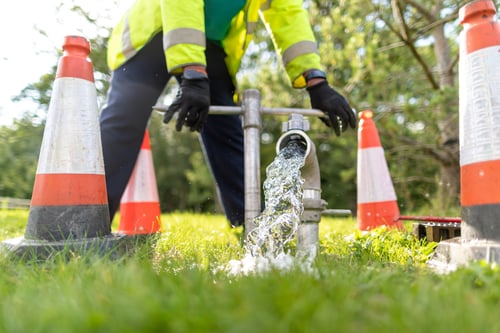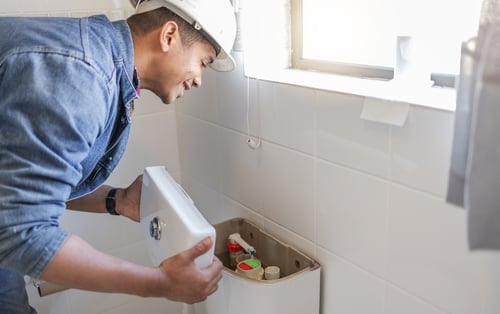.png)
Although it blends seamlessly into the ancient Chew Valley, the lake is a relatively modern addition to the landscape. But how does a lake that supplies hundreds of thousands of people spring up out of nowhere?
The story of Chew Valley Lake is one of sunken villages, Roman remains and a very royal visit. Join us as we recap the rich history of Chew Valley Lake.
Flooding the valley and finding hidden treasure
In the first half of the 20th Century, plans for a new reservoir to supply the Bristol area were being drawn up.
Chew Valley was decided as the ideal venue by Alexander Patterson, Bristol Water’s Chief Engineer, and an Act of Parliament submitted by the Bristol Waterworks Company was passed in 1939.
%20(2).png?width=950&height=550&name=Untitled%20(950%20%C3%97%20550%20px)%20(2).png)
Workers digging through vast amounts of rock during the construction of Chew Valley Lake.
Where the lake now lies, rich with wildlife and activity, was once the sleepy hamlet of Moreton. An agricultural community that was also home to a gunpowder factory, the farms and houses of Moreton had to be removed so that the area could be flooded.
To this day, when levels are low, you can still spot the remains of an old bridge, and rumour has it that there have even been sightings of an old church.
%20(1).png?width=950&height=550&name=Untitled%20(950%20%C3%97%20550%20px)%20(1).png) Two construction workers working on the site at Chew Valley Lake.
Two construction workers working on the site at Chew Valley Lake.
Before Moreton was submerged, archaeologists excavated the site. They uncovered Roman remains, including wooden writing tablets which are now on display at the Bristol City Museum and Art Gallery. Even older artefacts were uncovered from the Bronze Age and Iron Age, including stone knives, flint blades and the head of a mace.
Construction on the lake began in 1951, with 5,000 trees and 70 miles of hedgerows being cleared from the site. During the construction, thousands of trees and shrubs were re-planted, and the water was stocked with plentiful supplies of trout. The total cost of the project was around £1,750,000.
Welcoming the Queen to Chew Valley Lake
On April 17, 1956, HRH Queen Elizabeth II came to Chew Valley to celebrate the opening of the lake.
School children, construction workers and local authority figures all gathered to welcome the Queen. The houses of Chew Stoke and Chew Magna were grandly decorated, transforming the villages into a colourful display of flags, flowers, balloons and bunting. There was also a rather strange request for villagers to hang pyjamas from their windows to welcome the Queen, which was later revealed to be a hoax.
.png?width=950&height=550&name=Untitled%20design%20(82).png) From left to right: 1) The Daily Mail headline hoax asking villagers to hang out their pyjamas to welcome the Queen. Images 2 and 3) The Queen walks along the newly opened Chew Valley Lake. 4) The Queen and Prince Phillip are greeted by waving crowds as they drive through Chew Magna.
From left to right: 1) The Daily Mail headline hoax asking villagers to hang out their pyjamas to welcome the Queen. Images 2 and 3) The Queen walks along the newly opened Chew Valley Lake. 4) The Queen and Prince Phillip are greeted by waving crowds as they drive through Chew Magna.
The Queen and Prince Phillip arrived at the lake in an open top car, waving to guests as a marching band of Royal Marines led the way. The Queen gave a speech, thanking the crowds for their warm welcome and spoke of the importance of supplying Bristol and the surrounding areas with clean water. The Queen mentioned the scale of the project and marvelled at the research and hard work that went into planning and constructing the lake.
“Of all the tasks that our scientists and engineers are asked to undertake, one of the most important is the provision of pure water for the needs of a large city and its neighbourhoods. In this beautiful valley, Bristol Waterworks has carried out such a task by constructing this lake, which will be one of the most extensive man-made reservoirs in England or Wales.”
.png?width=950&height=550&name=Untitled%20design%20(83).png)
Queen Elizabeth II talks with workers who helped with the construction of Chew Valley Lake.
After unveiling a commemoration stone, The Queen ended her day by visiting Woodford Lodge for a spot of afternoon tea. Chew Valley Lake has been used ever since, not only to supply water to the local community, but for fishing, sailing, bird watching, walking, as well as being home for local wildlife.
Watch rare archive footage and colourful memories of the day in April 1956 when the young queen Elizabeth travelled through local villages including Chew Magna to open Chew valley lake. This film was made for Bristol Water to celebrate the 50th anniversary of the lakes opening.
Interested in visiting Chew Valley Lake? Head to our interactive Chew Valley Lake page to find out more.





